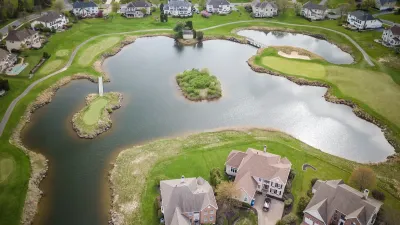When you buy a house, you might think that you are in control of that house and its value. But in reality, your house’s value depends on a wide variety of factors beyond your control, such as the perceived desirability of your neighbors, local highway and transit policies, and trends in national and regional housing markets. Your home may be your castle in a physical sense- but its value is heavily affected by what goes on outside the residential setting. In her new book The Unbounded Home, University of Chicago law professor Lee Fennell addresses the implications of this reality and of homeowners’ attempts to reassert control over property values through restrictive covenants and zoning.
When you buy a house, you might think that you are in
control of that house and its value. But in reality, your house's value
depends on a wide variety of factors beyond your control, such as the
perceived desirability of your neighbors, local highway and transit
policies, and trends in national and regional housing markets. Your
home may be your castle in a physical sense- but its value is heavily
affected by what goes on outside the residential setting.
In her new book The Unbounded Home, University of Chicago law professor
Lee Fennell addresses the implications of this reality and of
homeowners' attempts to reassert control over property values through
restrictive covenants and zoning.
Covenants are usually designed to protect property values by excluding
certain obnoxious activities. Through covenants, homeowners contract to
give away some of their property rights in exchange for a veto power
over nearby homeowners' use of their property rights. Zoning, by
contrast, involves municipal ordinances rather than enforceable private
contracts.
But under either system, a city or group of homeowners must either
absolutely prohibit or absolutely allow certain activities. Fennell
points out that this approach often leads to inefficiencies- that is,
rules that create X amount of harm to one homeowner (or group of
homeowners) while creating less-than-X amount of benefit to others.
Fennell suggests a statue of a gnome as an example. Suppose Beasley
lives in a community that has banned yard art such as garden gnomes.
Gnome privileges will win Beasley $600 in intangible psychic benefits,
an amount in excess of the $500 cost the gnomes will impose on the
community as a whole. Fennell suggests that a more efficient system
would allow Beasley to install the gnome and compensate the community
for its "loss", thus resulting in a societal surplus of $100. However,
both zoning law and covenant law are not flexible enough to allow these
type of transactions.
Fennell suggests a variety of market-oriented solutions to the gnome
problem, and critiques each proposed solution. One simple option would
be to create fee schedules for rule violations; homeowners could pay for
the right to install gnomes. But a set fee schedule might be too
inflexible, or lead to definitional problems. Fennell proposes a more
complex but possibly more equitable solution: using self-assessed
valuations to set fees. Under this system, the homeowner would set the
value of his right to install gnomes, and the city or association would
have to either purchase his right or let him pay for the right.
At the end of the book, Fennell makes a broader attack on homeownership
as currently conceived. She asks: if a buyer of ice cream doesn't have
to buy a stake in the company, why should the buyer of a home have to
purchase the risk of national and international housing trends? The
current system forces homeowners to put nearly all of their capital in
one investment, thus creating economic catastrophe when house values
plummet.
As a remedy, Fennell proposes "Homeownership 2.0"- unbundling the
physical value of a home itself from the broader economic risks of the
housing market. Ideally, investors would create financial products that
would allow a homeowner to alienate some of those risks. For example,
an investor would sell a kind of insurance against declining property
values, promising to make up some of the difference between existing
values and a future price in exchange for an insurance premium. Or the
investor would bet on housing price premiums, buying the right to
receive part of a house's appreciation; the homeowner would benefit by
using the money to invest in more diversified holdings. But as Fennell
admits, there are "many [design issues] that would have to be confronted
in translating the H2.0 concept into a workable policy." So someone else will have to do the detail work of figuring out how to make Homeownership 2.0 profitable.

Manufactured Crisis: Losing the Nation’s Largest Source of Unsubsidized Affordable Housing
Manufactured housing communities have long been an affordable housing option for millions of people living in the U.S., but that affordability is disappearing rapidly. How did we get here?

Americans May Be Stuck — But Why?
Americans are moving a lot less than they once did, and that is a problem. While Yoni Applebaum, in his highly-publicized article Stuck, gets the reasons badly wrong, it's still important to ask: why are we moving so much less than before?

Using Old Oil and Gas Wells for Green Energy Storage
Penn State researchers have found that repurposing abandoned oil and gas wells for geothermal-assisted compressed-air energy storage can boost efficiency, reduce environmental risks, and support clean energy and job transitions.

Greening Oakland’s School Grounds
With help from community partners like the Trust for Public Land, Oakland Unified School District is turning barren, asphalt-covered schoolyards into vibrant, green spaces that support outdoor learning, play, and student well-being.

California Governor Suspends CEQA Reviews for Utilities in Fire Areas
Utility restoration efforts in areas affected by the January wildfires in Los Angeles will be exempt from environmental regulations to speed up the rebuilding of essential infrastructure.

Native American Communities Prepare to Lead on Environmental Stewardship
In the face of federal threats to public lands and conservation efforts, indigenous groups continue to model nature-centered conservation efforts.
Urban Design for Planners 1: Software Tools
This six-course series explores essential urban design concepts using open source software and equips planners with the tools they need to participate fully in the urban design process.
Planning for Universal Design
Learn the tools for implementing Universal Design in planning regulations.
Heyer Gruel & Associates PA
City of Moreno Valley
Institute for Housing and Urban Development Studies (IHS)
City of Grandview
Harvard GSD Executive Education
Salt Lake City
NYU Wagner Graduate School of Public Service
City of Cambridge, Maryland






























